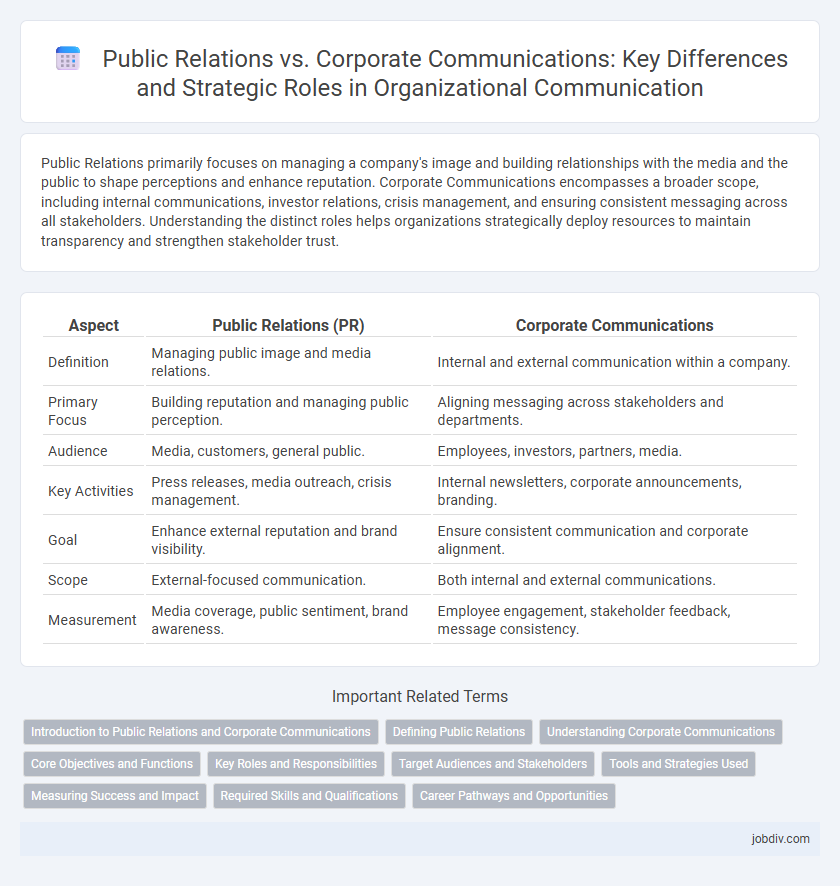Public Relations primarily focuses on managing a company's image and building relationships with the media and the public to shape perceptions and enhance reputation. Corporate Communications encompasses a broader scope, including internal communications, investor relations, crisis management, and ensuring consistent messaging across all stakeholders. Understanding the distinct roles helps organizations strategically deploy resources to maintain transparency and strengthen stakeholder trust.
Table of Comparison
| Aspect | Public Relations (PR) | Corporate Communications |
|---|---|---|
| Definition | Managing public image and media relations. | Internal and external communication within a company. |
| Primary Focus | Building reputation and managing public perception. | Aligning messaging across stakeholders and departments. |
| Audience | Media, customers, general public. | Employees, investors, partners, media. |
| Key Activities | Press releases, media outreach, crisis management. | Internal newsletters, corporate announcements, branding. |
| Goal | Enhance external reputation and brand visibility. | Ensure consistent communication and corporate alignment. |
| Scope | External-focused communication. | Both internal and external communications. |
| Measurement | Media coverage, public sentiment, brand awareness. | Employee engagement, stakeholder feedback, message consistency. |
Introduction to Public Relations and Corporate Communications
Public Relations involves managing the public image and relationships of an organization through media outreach, press releases, and event coordination to build positive brand perception. Corporate Communications encompasses both internal and external messaging, including employee communications, investor relations, and crisis management, aiming to maintain consistent and transparent dialogue. Both fields prioritize strategic storytelling and reputation management but differ in scope, with Public Relations focusing primarily on external audiences while Corporate Communications addresses a broader range of stakeholders.
Defining Public Relations
Public Relations (PR) involves managing a company's reputation through strategic communication with external audiences such as customers, media, and stakeholders. PR centers on building and maintaining a positive public image to influence public perception and foster trust. Key activities include media relations, crisis management, and event coordination, distinct from Corporate Communications which often focuses on internal messaging and organizational alignment.
Understanding Corporate Communications
Corporate communications encompass managing internal and external messaging to align a company's mission, values, and strategies with target audiences, ensuring consistent brand reputation and stakeholder trust. This discipline integrates media relations, employee communications, crisis management, and corporate social responsibility initiatives to create a cohesive narrative that supports organizational goals. Understanding corporate communications requires recognizing its role in shaping public perception and fostering transparent, two-way communication channels between a corporation and its diverse stakeholders.
Core Objectives and Functions
Public Relations primarily focuses on managing brand reputation and fostering positive relationships with external audiences such as media and customers, aiming to influence public perception through strategic storytelling and media outreach. Corporate Communications encompasses a broader scope, including internal communication, crisis management, and aligning messaging across all organizational levels to ensure consistency and support overall business objectives. While PR targets external engagement and brand image, Corporate Communications integrates both internal and external stakeholders to maintain organizational coherence and strategic alignment.
Key Roles and Responsibilities
Public Relations centers on managing external media relations, building brand reputation, and crafting press releases to influence public perception. Corporate Communications encompasses broader internal and external messaging strategies, stakeholder engagement, crisis communication, and aligning messaging with corporate values. Both functions collaborate to ensure consistent brand identity and effective information dissemination across all audiences.
Target Audiences and Stakeholders
Public Relations primarily targets external audiences such as customers, media, and the general public to build brand reputation and manage public perception. Corporate Communications encompass a broader scope, addressing both internal stakeholders like employees and external ones including investors, regulators, and community members. Understanding the distinct target audiences allows organizations to tailor messages effectively, ensuring strategic alignment and stakeholder engagement across different communication channels.
Tools and Strategies Used
Public Relations primarily utilizes media relations, press releases, and event management to build brand reputation and manage public perception. Corporate Communications employs internal newsletters, employee engagement programs, and crisis communication plans to ensure consistent messaging within the organization. Both disciplines leverage digital platforms, social media monitoring, and content creation tools to enhance stakeholder engagement and message dissemination.
Measuring Success and Impact
Measuring success in Public Relations typically involves tracking media coverage, sentiment analysis, and audience engagement metrics to evaluate brand visibility and reputation. Corporate Communications focuses on internal metrics such as employee feedback, communication effectiveness surveys, and alignment with organizational goals to gauge impact. Both disciplines use data analytics and key performance indicators (KPIs) tailored to their specific objectives to ensure strategic communication outcomes.
Required Skills and Qualifications
Effective public relations professionals require strong interpersonal and media relations skills, alongside expertise in crisis management and content creation. Corporate communications specialists need a deep understanding of internal communication strategies, leadership engagement, and brand consistency with proficiency in strategic planning and stakeholder management. Both roles benefit from excellent writing abilities, digital literacy, and experience in data analysis to measure communication impact.
Career Pathways and Opportunities
Public Relations careers primarily focus on managing media relations, brand reputation, and external stakeholder engagement, often leading to roles such as PR Specialist, Media Relations Manager, or Communications Consultant. Corporate Communications offers broader opportunities, encompassing internal communications, employee engagement, crisis communication, and executive messaging, with potential positions including Corporate Communications Manager, Internal Communications Director, or Chief Communications Officer. Both fields provide pathways to leadership roles, but Corporate Communications typically demands strategic oversight across diverse communication channels within larger organizations.
Public Relations vs Corporate Communications Infographic

 jobdiv.com
jobdiv.com